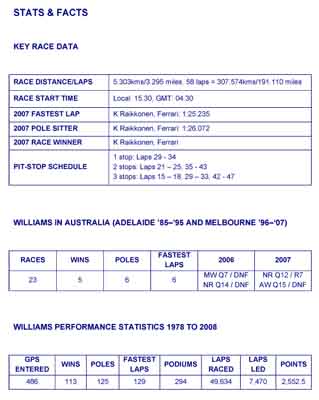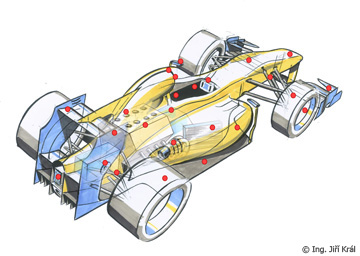Tisková informace - WilliamsF1 (EN)
Miroslav Sanytrák | 13.3.08 | Aktuality
AUSTRALIAN GRAND PRIX PREVIEW
TUESDAY 11 MARCH, 2008
Formula One roars back into action this weekend for the start of the 2008 FIA
World Championship at Melbourne’s picturesque Albert Park circuit in Victoria,
Australia. The AT&T Williams team will return to the race track with Nico
Rosberg, who will be entering his third season as a race driver having agreed a long term contract with the team over the winter. Kazuki Nakajima will line up
alongside Rosberg and will be making his Formula One season debut following
promotion from his role as the team’s 2007 test driver and a successful
campaign in GP2 last year.
The new driver line-up will be piloting AT&T Williams’ 2008 championship
contender, the FW30. Spring-boarding off the FW29’s engineering principles,
the FW30 is a clear progression of a thoroughly tested platform and has proved
to be consistent over 30 car days and 10,435 kilometres of testing over the
winter. Its true test, however, will only come once the flag drops for Sunday’s
race.
Nico Rosberg
I travelled out to Australia early for a driver day in Sydney with RBS; it’s now an
annual event and is always one of the best sponsor trips. Looking ahead to the
race, I’m looking forward to getting to Melbourne and getting the season
underway, and there’s a good chance that we will be stronger at Albert Park this
year than we were last year.
Saturday’s qualifying results will provide the moment of truth for all of the teams
and will reveal testing bluffs and low fuel runs. I believe that we will have a solid
race this weekend and will look to bring home some points. Reliability-wise, it
will be challenging to achieve our target of 100% this season, but we’re in good
shape.
Kazuki Nakajima
It’s amazing that the first race of the season is finally here and I’m obviously
really excited to get my debut year in Formula One underway. We’ve been
working hard over winter testing and done a lot of good preparation work so the
team is looking forward to racing again.
Because Melbourne is a street circuit, it will be quite slippery when we do our
initial runs, but it should have settled down by Saturday. The track is a good
combination of slow and medium speed corners, with some fast ones thrown in
as well. It’s also looking like it will be a hot race, which will suit the car. I feel like
I’ve been testing for quite a long time now, so it’ll be good to actually race!
Sam Michael, Technical Director, Williams F1
Heading off to the first race of the year is always an exciting time for everyone.
There is a great buzz among the teams before the racing starts again because
it allows us to see where our performance lies relative to each other. From the
last race in 2007 to the first race in 2008 testing provides some indication, but
not the solid reference point that racing offers.
With regards to the track, Melbourne is a low grip street circuit so special
attention is required when it comes to the mechanical set-up of the car to get
the best out of the Bridgestone tyres. Nico and Kazuki are both well prepared
going into the season ahead, as is the car, which has covered thousands of
kilometres on the test track over the winter to ensure strong race reliability
Albert Park, Melbourne
The 5.303km Albert Park track is one of the few street circuits on the calendar
and therefore used by everyday road traffic when Formula One isn’t in town. As
a result, drivers are faced with minimal grip levels during the race weekend’s
opening sessions, combined with the recent ban on traction control, the circuit’s
limited run-off areas may claim some unprecedented victims over the weekend
before grip levels improve as the cars lay rubber.
On track, Albert Park blends a testing mix of short straights (on which the
drivers will reach speeds in excess of 300km/h and spend 70% of the lap at full
throttle), interspersed with 16 slow and medium speed corners, which will
demand nearly 3,500 gear changes during the race.
Torque to power the cars out of the corners, a balanced set-up, a robust
gearbox and stability under braking are therefore all essential components to
achieve a successful lap during qualifying and a strong result at the Australian
Grand Prix.
|





